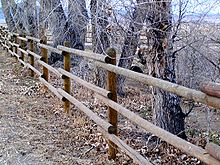This article needs additional citations for verification. (December 2007) |

In agriculture, fences are used to keep animals in or out of an area. They can be made from a wide variety of materials, depending on terrain, location and animals to be confined. Most agricultural fencing averages about 4 feet (1.2 m) high, and in some places, the height and construction of fences designed to hold livestock is mandated by law.
A fencerow is the strip of land by a fence that is left uncultivated. It may be a hedgerow or a shelterbelt (windbreak) or a refugee for native plants. If not too narrow, it acts as a habitat corridor.[1][2]
- ^ "Fencerows". Missouri Dept. of Conservation.
A brushy fencerow, which can provide an important link between different habitat types on your property, is an ideal place to start habitat improvement work. The simplest way to make or improve a travel lane is to stop mowing, grazing, or cultivating the strip next to the fence.
- ^ "Hedgerows". Farmscape Ecology Program. Hawthorne Valley, NY.
When we discuss "hedgerows", we also mean windbreaks or fencerows – basically any stretch of woody vegetation bordered on either side by grass and/or brush.
